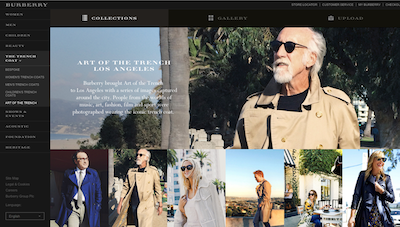NEW YORK – A brand is a living entity constantly adapting to external forces, according to an executive from Interbrand at the Luxury Insights Summit 2015 April 29.
The current landscape is consumer-centric, and each individual person will play an active role in shaping brands and deciding which fail or thrive. To be successful, brands will need to focus on creating value and maintaining authenticity for both themselves and consumers.
"It’s the logical progression of this conversation to begin to understand that the world will be composed of 7 billion brands, that each one of us will define based on our unique worldview and selfview, the brand that we are and the brands that participate in defining who we are," said Tom Zara, executive director of strategy at Interbrand.
"So this is an acknowledgement that the brands that we own, the brands that we manage, the brands that we are responsible for building are not ours, they never will be," he said. "They are the marketplace and the customer’s worldview."
Luxury Insights Summit 2015 was organized by Luxury Daily.
Brand strategy
The rules around branding change at a rapid pace.
At about the turn of the 1900s, branding was focused on identification, ensuring that a brand had an established awareness and distinction by pushing communications through mass media and expanding distribution through transportation innovations such as the railroad. Instead of being an integral part of a company’s business, the brand was handled by an isolated part of the marketing team.

Tiffany's blue boxes gained traction during the age of identity
In the late 20th century, branding gained a place within the executive arm of organizations, influencing decisions on corporate strategy, including hiring and research and development.
In 1988, Interbrand began calculating brand value based on the revenue driven by a particular brand, since powerful brands that are managed effectively lead to stronger businesses.
In its 15th annual Best Global Brands 2014 report, Louis Vuitton, Hermès and Burberry were ranked among the top 100 global brands (see story).
Burberry is a prime example of a brand that has adapted to changing times. In 2006, Angela Ahrendts became its CEO, with the goal of making the first digital luxury label, making organizational changes such as employee skillset and engaging with consumers on social media.

Screenshot of Burberry's Art of the Trench
As a result, the brand’s value jumped from $2.4 billion to $5.2 billion from 2006 to 2013.
“Courage, insight, belief that brands can change allowed her to innovate in ways no one could have possibly imagined,” Mr. Zara said.
Following the age of identity and the age of value is the age of experience, which is the current landscape. This is driven by consumer-centric culture, where brands that succeed are those that cater to their needs through personalization or engagement.
Mr. Zara used Tesla and Apple as examples of brands that speak to the age of experience. Tesla is more than a car brand, with a brand philosophy that is focused on making an impact on the environment. Apple on the other hand has changed expectations through its consistent engagement.

Tesla vehicle
Within the age of experience, data presents an opportunity to build a genuine relationship with each consumer.
Each new age builds upon and incorporates what has come before it, and each serves as an important piece of the branding puzzle.
Looking toward the future, Mr. Zara anticipates an “age of you,” where each of the world’s 7 billion consumers will become their own brand, and their decisions of which brands to interact with will have more power to shape a brand’s identity than the company’s in-house team. Within this new age, data will become more important than a brand’s financial assets.
Within the age of you, luxury is defined by exclusivity and purpose. Brands need to work to protect their rarity and craftsmanship in order to retain their appeal and status in a landscape of secondhand stores and counterfeit goods.
"There is a correlation between value and price and we operate that way all the time," Mr. Zara said. "If it’s really expensive, I’m assuming it’s really valuable, and if it’s cheap and I perceive it to have the same value, then you’re permitting a secondary marketplace to thrive at the expense of the brand. It’s like counterfeit products.
"At the end of the day, brands that have authenticity and brands that have legitimacy and brands that protect themselves to ensure that the market they serve is not corrupted by a market you don’t serve, and I think it’s just a question of being very careful about the access you create and the access that’s being created for those brands, to ensure that at the end of the day, the value equation isn’t corrupted," he said. "I think that’s a really hard deal because commerce is everybody’s garage. So how you control that and how that lives in the world of open markets and access is a frontier that I don’t think everybody’s figured out.
"It would worry me, because I want to be able to command a premium on the strength of the brand."

Tom Zara
While luxury often prides itself on exclusivity, it is not outside of popular culture, so it also needs to listen to what a mass audience is saying about its place in society.
For instance, if millennials are negative about a particular brand, and it is mismanaged, it may end up in a “desert of dead brands.”
Mr. Zara said the top brands understand this and actively work to communicate their values. For instance, Tiffany directly addresses its relationship to the diamond industry and the associated labor issues.
Changing with care
While technology can be incorporated in some ways, for instance digital interactions or advanced mechanics in cars, incorporating it to create efficiency in production can tarnish a brand’s rarity. A number of brands have bridged this gap between modernity and history, keeping their heritage central.
Since its founding in 1837, Hermès has had to adapt to changing times, requiring a balance of modernity with tradition, according to the brand’s CEO at the Condé Nast International Luxury Conference April 22.
Helping it remain a presence over the years has been Hermès’ willingness to embrace new methods of communication and adapt its existing craftsmanship when working with what materials are available. As technology evolves, luxury brands must take the lead in a way which maintains their core values and aesthetic (see story).
For luxury brands, protecting their image is even more important, since affluent consumers are more exacting in their choices, since they can afford to be.
"When you have the financial capacity to participate in luxury brands, these become even more profound, because they have an exercise choice like no one we know," Mr. Zara said.
"Mass brands, that’s a different deal. How we look at Walmart is a completely different mindset of marketing opportunity," he said. "Luxury is a very different animal.
"For us, it’s just amplifying the ability for the buyer to make a choice is far greater than it is in mass market, so these constructs apply to all brands. Our view is they just become more heightened when they apply to luxury brands.
"There’s a lot more to lose, a lot more to gain."
Final Take
Sarah Jones, staff reporter on Luxury Daily, New York
{"ct":"a\/BiqyaQMMOlWobbc533YQhmtX0rTb+p9qrct8Io1aOOVNSzhPk65cKVgh9aJBWfw3OHN1loCryvJfGyn5HR\/BYQNlqv8\/mwbfxGqgJ5x1pOPg2OOkBERTVeVmhyjxmmAATVHMbGQokrFLDbYEDx6dY8BWPMRcnsUQzTwJAijrnZGrmGWFMTgbJs91FVJwhqWN\/IxuRPAfr3bGaKtSNAx9tHVgNEga\/IBvckYh6cTgyTXkJHgIc6VyLyMZpptxw2zup7el0dEAz3swejC6ydEBKkFHWSxR\/5qeK7kTkZj51A2F3z3nha71b3lwvOsidemX+ALPPPauc\/o8luL4UutRGgQ+AC0gd2RI6jG1O0usF2MSbgjsr3XJ\/CIC4tDWSmW4huOqb79R\/HRMswR8ScDY7rvwV5LqcwwlneaBiImqtRF2pMBYWyQsD+1TSsVhVCBlK0ZltnORxIU+P7eXBDIy7l3tMrRec82X1Ew\/1zpO5R\/WZSQuoIFyKXtqz7VFj5wn\/w6U7Led8k5qRXlX5DjtgrWTbk7h33Wa2RPthyMD4xgAQl8JpX53LJ2njdln2ixre5H5Uz4gZHcURY9tw8moK3WW4\/1ucA6XNnVX4X8ElQD63679rRHe\/h+zr3wm4GpcvdgttQJJP8IfPfAqwTlBjkQ8Ek1jn0S3h\/6KkN2aSGY4uYOY7emIXLtpOd3MFP7m50ppCg\/k7geVfQ1MODJ9qMVJgxY8Uk4KfY+8HgAH2R\/8DU6BC+J\/Ir854zaSsv5rzM\/KxXgx4yJw0tJhzcAwBtiyVai38Gw0p9jej\/xASrBCy+5W5n7J02m7ATLCPtk0yfzQJAjFzl7uJ2RHhGuoz6ArYxOB3nmqBGYYM\/pdhCFEEoA3kaptJW5jNaIRkeE\/257jgK4HZhH9+3LdmNY74eMSsJn2qIO0eS2xbtLMI0shiCmUjBSkRxkvAPTM2fOTole\/R3WWh+lqX9GAw+r2pFKYYy\/ZBmDb8bwAcWtLFRDww03siwsbxqx0VrkbZYHlyRmQTOu7UzP\/4tHqTyt5dM52lUbXXVwOETzhu6xgrwFUrXHM4XEFedZ49MG1mPbXfrCBgLqgct0wfUqFq6DQ6jFbAZP2q1w6DKoMRlu7lV\/mO82bnpLVIgInJQeFVsJnmDVI+i97oQiodUmsTAjI0fcOecqaV6rKjrLbwACB7ddCmt4ZynDo50TXTAQji45tXqx2InBAAWQQ\/R875Argo9KgL0tUY\/3BdckohCKRCSOdjQOvUVTnWnO\/EqsuPUv+sIDrTCdQemG8qFryYEcKcaRIU9vnVmA5ScHNOmG2IaZlDVhhXaiV6KUx04dC8SVKb7DFw5cbMrsJ42oP2qTKU5m2QBuWTIeqBIj0LaID2R4aX5JU5WKIo58NSkzYmY9QIN+7KxzD1favTy2Ve3h6v3Y0eKnZdCTh3ooi8XoCACruqBGAf2g+hJBlZfLAe7yXttprVy2M1MBgj\/sQnTZFuNvap4N6c34ZrwIeLVurs3Qvoye9e\/wHmCpxKDKRIiLVkRRNNBoYkXd5stmKrWejy+OodoRQWsSb7siXKv9evtmigD4pBUi8wLDYkyWWJeJAI8529jGuC1Cwich3fL1HBUNNedtSQTtTlvwvHgvZdy\/bBDEuWxsSExipzbIGGP0icFYRHIPzoNcSAtS\/\/C2n05iLmvtnKi7f5TuXbTb6kJAPjRtWUmZn9tdN0IiwovxjJc62fzOOSF6hlJ1UavGEK+U+j0bqtvFvJIVBAF9Ws7qSFES\/W2VX1sPbgMjkhAfRHvvuRiYOCCxhyqgN14dqHrop9vEGtF86HnCsYohKskqIYo2VyOFjCDiN+Hmv2gKR+ZIeoUJQwD11UrdmG0RHwHjkMZoEpRheBMe82tHSEtBt73wFsgpzzkDfd\/aiq6jnMkTnz+dDv68i\/oGue0rnoDXfsP+9laEZLKLcqrqcQA3auKFIlKPekkwZxDg9C8bpEQgxSoQ3brkfUWmJsjVb1UtaPB6DXqfjcSrrwJdF3a+ueKfV0RiDlGjxXt3f2FGrcicmi22\/3xh6eqaajlpV5WCa6vCFkW\/i4vCxaMfwW0qe96td3A18IgktSrYYhS66rL8Ah4hoWnth+39IobVnr0PZtvc+4KzIKbqOjaW6ts6\/aNn1\/+jfqD\/QibvsIg9iR3GgmKQ7DoW+cCPuWzzmDoyyqVt1ihJDxPBeKRmTD8D96xNQEUJldcn6hheWMPcL3SHqoPQRNO1oH80bTMaU4o0BYVEEoKGAJ4mfHBvM4RWXzUK1r7iAtxo\/7RaEBThYDG6d\/kdN7mLXivAhoBo3lOb\/1fhRxPy\/0J7xOZWyrHwLWux1SLoksdHbfdG7sYrRZlqu+LC48NZexp+WCOf3MUWfthXBgqLtpAbvrG4Sos8skt\/ADq5K0YscUmFROQTp01RraZPoEvPNfFUGOr+vFWFQ8lzR3WxUcTKOYo96nLTDIdP2qgjgH3nHFYNgspUrvH3o5SMGgyKQtQBtH8tm10TdC6wszoyKd26FVf2+Smjz4A5kkR72ni\/wiFKrhYHHfm9NMdSTRAuhGX6DeJ232zZfVoVhGCSYdDjidfvz6QM8JEA\/KCj7y9+UmVZ\/iYl18I+8VXfKWJXs+qnkDILQBQ0+ZsnlTu8+w929uXPujtED2QfKxwBModeOgpeC\/v6pQtIp3aJk5Z+ZMxpEhCdVgF\/EkfpB1lD97Qyo4DOTB6i7XFOL+\/rYVgsK1RNKXbA5J4E+doM7zHcc2l57pIivoxhXRD9Ug8ghfGKZo5EGHSQZdVPBgecFfkKOZnlFwY+qeVsKDyaU08r\/CcXOtDUQPAiCqoGY5drl33gjlBTUZnknEF3wcM+PPofH9Esi\/9fEiZJ2rI6ekVgqBXKQXXMulTpFQieRLN34RLO104aog+AZRnjkDef3k50N8PGqMIlfCSgtrQAIh3oXJmxzGc3cp22zB3XAuLRHHGdAlcLbn6Fscwc5u3H1wAz6zpAiNhBAThtZ3pAK7s5smBz1Pp8eAKSi62vBDiioS8ztRL1RR5sYIGmTUXMyJYrB0E\/+9qQpV31PEArDqNb7x4LcSs5wlgesogQXjvITxvd\/GAcnyk2dfXddQgieFb3VpGgSodcCG18PN18VOtwnPfyuxIcQ+RrvapMgi6xdcXfmw73tjs4idGnE1PB5r86dqxibg5\/GLjHnpspkRy2Y4i6iKHB7BrgdzzFL\/joMmpCJw1wiixOYlIqmd6wA5kkOc4922yPN6qipduHvu6aMosizT2IHODItE2a1+JEACrkT5V4IZ\/3KpHHIr2AR3cJkSGnXmV+FqDgJQra\/oKTIW2Z5Ify7SVG5pCQhos1Yeym3NqN3Cp+bH5dQFXilLPWT1MMaw8xzIU3HRAMqFpklr9Dvsc7IU7vJsnnx79OHToLXjjJTcBbLOjDsmpXK\/t+FoBjdhoss8LuVoU8ybUbyJXGSAXDv8\/t6n7No5AeryPAv+RaW04mJ34jT6kWM7oShGyhwcPxgYEYzcCH0ef4sXyJbGdHFi14dFWP6nhQhaIT1C1j2jLz0m9KD5ZD\/JgGL7KED0tj3+rtCT1+iaH9oQZ715klMMu6yrx\/hBH9ScpujaFSLCBLJFsrN5IAThyKVbDdQROGozxARpu+blUgKXYKxHXAXCh119RqgaaeTlmFesTFsBDNHO4kIktzuDwBnecntKX+HgDst3hnN+Wv0itTNasho1IOdvSlf+aZo1I5pH5o98QHzOEnxrBfwUkDuThrUf\/4JLYLXAsyDRKIBoRESu0MsIHaV7rs7d6vgVakpNqIVobx7tl0msYVcx40fQsyXJva1WrsAYg2QnEbJ3zNvmHaV0qC+GR0rsnJMPlxFaKeh11QtG9lYYXpIO\/SDM5\/qQTmLCDCqQ9AWj4fuy8i3KCk7dKmb1udvbxytsoKcqp6Qg1FzFhBa52jTe7dYQjLeHPPZltORte8QXr3O31\/6lq5fkZepOHXo7ap0MQf3pllA8h59PB3TsZSHuRwlqYf\/hLkiQiasH3dZKo95693ZUudoiEKe3AwoggAJ3S26H7kSQ4S20XXkroKJDELt2z\/6Nu3D1NW+DZCISChrsJCjHPPPq1aNRVnHaIzSBQtOG67DSHjhf22ANX7\/WzsLGJzbXTIenmv7wVQin6uxRsiGHu3PPNwfGvosE9u6ihro2IAtn+A2DmOCWblo0VJF8rZvYTzkkEMZpT+c34HdCmijI6nflIRScXzjx5qwBYY6HoRTiHvSQGJmeEGUy7EOUkAenaxpPMB11Erwr4rlxjHfkP6uboR9\/WQLQ7+MXnMBCpYdNBh25GVLL0TdooCvg01CBidPifthX5O3jD57\/Ifm4oOHR8bDjaaiYAtI\/0JvXyR50Z4mo0+Nd22tE1LFhELDUvckYFVCDHEITo1KmHSNZJ15NT8s1Vl0SA+xMhPTt+hcVSZgP9U8Xh\/Gx3dlqd46dcpu\/Xxxk7SpqB3VfPLjf1yvhLOuw9AwHo7UP38AAHeRkSyhVWfAR8vpRcNKoMM9UT3LwfPuJ+QSMI6WDF2er0Dj6EngJMx0A8tzjEyaC4R5YIM9TBK7xNE16Le0J6ebSK3ryBEkd9wADNYsmWq6\/jiqHCPG3EDOuBrZmcZQHPTHUzrmcR+fIe8frxeiF8XXrOnwAjPdtFnhvcEAf\/HK4biXPs8bMWfgX+m7lgrLz2QjAjT4ae4BeLiUH+6mTpLuwhtl2\/RDYlMoMgfUHSPdxNf2e9qTkdzdm\/XQuJMxWPwETkDGbJ7zfrlMOLCeHqBtTVUYhbqdU+uFJYwRWtTNvYPVZpWYSvD0WCufXAITvFV7BuapbX\/DaZULxoMghqSE81\/KbMjaXb6Gt1I9agMPXqFAMFhZMfkCKoUQKX\/XvBGcROG8Jdoc8QV7ZKo7FptfjMqnNQu1fQoUrpl6vtrgi7enpk+5Wo3P5VUlGeDFwDp\/ts3my\/MAR5CZ3Wmsu0lfr3GjsPN+1zzxNj61VWaUYe6jMls8t1Lr1svRzJACr53rI66BRulKkR+gqlUgZxGHEQ\/BTH13tn9bdHMlGlBcSHJeiwTNb4uJgQxL1nAK0TphjFmjS8Fe7+fwmno6ywYQF7cgV6NZsXRw8W0uzepkYPh4krBpRdhHF+1oHnRG1SE+iq8cJVY5trlmZP49F5xDE+jK1eKtEjCsm0EP+QFdVX5HOB7z+SiMKD1xtkQuglHYsWPlhr0R8kdwjBVXJGQR12Io5+wsv\/0ZEVuPwCoNOknggIs+JwAbJnLid2vPNYQM93GHXgBm8gXQXMNO9uZp0yFOaG0OSRGTv+xs2cbgpTsPATaiaGhwdWl8gSchdeneGY0QZIsQ5ntmIBpc+8IfwHrEHM8TLksw3wBiQlhAANS5gge64OWDsxI9VP6aTkCpqTsDUzwXbAttCHfLNNJvEJNHPe4WPYvuh0VshcfShzKz\/4H+is5kTk9hmU1FMEF4tk\/z345cV6un5Y4lTtA2NZMLrmrpOodU3b63zK9JDpHG+hFMXFd5qfCM8k3Qv7u6tTra1Rzsg2dZEtKxEvSOdBBvSlPb+cI+H5aare21sUdEXm6c7kJCmlZWy6ibljg\/NmR0CwNrPApWps2JHAUy1+MvT2EwcSbklUUKgO8+T50WEM3nqoopl4WvsV6rsdNnO+5MjD\/UtPxA2nMAdUgQBrBqaORK1ts9Jw+P\/MKWnKZ3Tg9g8qToN6bRjvFpDRdR2o8tELG0uHYbBoJxooy67sEoEeeJGopmaT0W000A6KVSZyGc8TYC+hoZJl8AfV+yU5Xy5aRgKBKN61cVpgfNN\/LkQUvFVyZZS+YVUc06\/2BS+T33V1RBla8zAffAdnF4uYVuyfnUj8bNQjebUAg3z7KvmmvoQbQtRGM3CTqMfsa0aQYefXhVua29zNmeIzML\/LlmLnM6XlapIfpJ2NyaPNPdkpqY8pawKmNAVlKaTJ1BiEqhLkerJi3MQ9Y6WDoNoXORmFl2UZ73HMBO3w+dSC+Ci5bwH+3xygNXvRJjE\/MtnJlrVgKXU4bkwHSKngwq35DyClRox9uTYL+cDxJlNMkvNZmIRU7th4Q35k8uhIJbAvSV1zATn9QR7Ue6s9gqxqiGZMnbNWfgZ9UrTIy8iXCUpJE2NnlEif5mkcYzWZBIZVrhPvZBP2+4qDkqaYtzx54uCGNepSKyX3guZpwfB8MGsFi8DLDrsScueAj4yXAsB6Z1jrvLGNzbuQ\/UZUUN8XKEDgDEJ9Y6YegLAeuPSANuZi4dqFmkDQ5D8nPlBQbr5G4KXW9cAQpyAngxAnkkkI7hRQO4Jt5rlXLh\/HkcOXLQRUoQ2\/CF5lapxjBXQNB+Lb3bapbjYZQ9036s7ghtUvczTKoMk7vSwsp6pJeDJBRaDZLMdP2Y34Div9UHWISnilDapwmIc1HTPsdotc8hl04UwEZMAsDYWeov64KTnWbps3zRxvYg6Ij87iXZY7igO9AVWpgiQ\/NLYq+mHkfwtblPVCIjR1jdIC+nroI3kQB5PMk8vA7kylRK17zgkGrV2WBGypGXOFg96E5W0G1C\/nWJg++vWezls4Tk67kHi8pHZHKNk1lDafjZ6NlQTM0TyMtIWf8UPRZh+z8i3Lz3epWzR\/wwRnqC3ehCFigMf\/znCiGzBwEqadTQ15n06CdotRO4V+FWZTXPaZyikwHSf5VZ9chBIvlHGbOwSmqJKFwAuNZgcGwK+Sckp\/beWxkcyuJ5sVcl8NfDNxODVkX4e+Ur8riGkL1r4nWRwhW0AGsihpvBjExUkCYKIjGSuyscp6KaeXdJiY8uC1tu\/u4X3Jhm2CK2N3MRy3TnYc05vfmNx+Nbt4t+GUW8K4925LUmiSVGsFlmBurGgDhuOTX21zVQGCceH61lkD48V+4NFxaz6VAxnUE8qqBsKWuJSyXsT37Gb912oeu13GJmQ0r8IDK5PuhbI0agck9G6ha\/wVL6Lh6UxsZBPPxsa9rbcCGSXKmiuu76lWSzmLOF5eDusoXEezj1k2Mg75AquG6dAWELEvL5G01ALznOluoRYpMvz8lsza0kOtP8GOTSyyyUV\/SIUfJAW5wJUsiUlprghU9U9jcVQ759s2v7F\/xtHjHdIuyaUAtkJGnYdBAjWjo2KCWRP9GpD7w8T33u4LohObXZLCzujDgH9jdIz0nmKuOP\/ynU\/jDedBYBnDiL2560nEgZJZJQgLYn+7vF+uZaJUyykOGi+dL68A4Zjo4cSQxd5Lkdz+uipAD\/AYxtDHzS07qaQRGQQ0GGQt3AeDe\/IghMyNywG43JvyjwSGMfHCZ05YunvDYL1YNLzlDAGZ1BOE+JRHmW67nJmfpfcEzRFH89vti43ccMsqyATgeyCgGyMPReoEseZP5h+HmFK4yD6E77FsZdLfX5rBHL84wtP99GyeifY3xXCyVr0WPU7RieE\/mPTZrpjLW1gaY6P1IqAvRK\/+pYfQzjBduLukYVIMS4z3jOtynwVX\/q\/2k7Qr9bf7eKjGMLnTL5h5ELc6K8FyFnSJ6XTK1sabL+eV39fZ3FICVuZ5n0948nO+0CY\/T0O\/monaEx2M3JeQyqm86tXnTMSQ2t\/1cGJ4vNj2E6yrTbRJFVBc0h9OCRseKNpd62736qmwp\/jNHKTYE+3QElme6nckCWUjq04DybnI615Q54R\/cofAyzsf1t846h8GOe2plpUuFJUgMLTzDz0nK04atA8gVY1ow2zxc7PruH3dXbYkYGkptZtdiKaRhENUTo7fEmyuV2zgB5Du5qqORazEd0sAUCzICJos\/ME7wiUwzPjP\/rTvZ3oaX24wIJNtEA9THkzbA+H3jeI22vOBn9z+K+\/h21qv2hUuB\/W5wD3NB9upPM1tbJVNPWCUqBje9v9g0lEh37xJtcSITa2wTKKAeisKEjTckbjSP4QcQABpqb0aL7G2AXpyHDOdoeQMnq5w0qG8lEvjWxNRI8+1r1EBGBYigQxefYCC+oOE2JBam4Fgxirc\/us\/if+\/dk+2bQpM7ijel86lXr6kFC564br1CXT1zU+1pJGZD6BHjx4N0WD5ISef9auo85zwZEc14R8RWwJWiTMtMt\/FRHnPUMkTPbyLVXDz\/QFYXvW+2ymmG1X0HFu9\/xTWGnchp3MqzNriv7+WiSXrUtIBNf8zkf9bbDskpXYDV\/wxQoxW0omCQCwPEA2uArqJTdKSOTrQdwA\/L00qI4CxIhLmwD0P8EDSqI8pK0ejZMksOFPNywAv+xVKBENPatFPp3Hx0MFuw7Xpzul1UrQENwuooOWA7l3PEKR4VlUiEPr4RWn1gyjB5NW3jf7KVCyckJaggCxRt71\/GDc+Egzx9nupF6LU9Dwg+4KyU4hySz\/ZY9G2T3DvOwcaiDcxqiIFvQ6ODQeTgW4ZQHb4Mf+I5Pvzgaa1UdGCotMFJqOngp0IFlDXNli3G6MotU9JClzDNMVH3SeN3DJ8omynlk37kXczkMT0jbLGNJA+YIB4seWXwUBubHnWYWrfQAyCBqC\/\/3HokrV6mOkaxp0uvjCvlYqauTvv7seTKRSjvRny0Swu20teB+InFi9DLpZz0jpPhNQEWZBvq27cwkCTLi8TFKV0PK2sYzwBRrjVfH3W9y3rvQt6J8DMyBdu+eld3z1Oy2e1Bk9QuPnWQFrgET7hn+gD9dMitnkQrZiVhFXYKMsgrX7i98bueUyNyg54iYfk7Ml2g05Ees6TnUtCGswOEAIi\/ftvhy6TRFAvwA5eUCOBzGfJV38BqpfpiErpYlz+Ie2bR2lAF4CQ4J6w6RSjvcXlBfP2mRzcRE+K3VzufpfPpWAUeAleXVvqdTlLpmcQpm+5HQe0T88R78LCrunpmOFx6Thiz2jbJJjC179ZWDkMtyTWdbsMbBhNJvYvHgIZo7VoXiBFn5kc9G1kx4KHKS1Oay5ALNx\/TA\/57ItGSD0ebZDauXYhXyelUBno1bhNAsn94y8FVrFtsUXSdXish69A+USMoA2Kx2nWCX4dCyFKy1EaMpmdBjxwTpzrMD4SIZlU8sDB9cg2CqlNQvOzjE1PRcatFA\/jU9FegXySKZ26GGNoRpeevJl+Jvz6SJpr3hTDU5ywELKpJXTyaJSP4CNQcJF1Rp67uFV2QVf8ct02SiGujOH8SzyVpI7NYEMBv2OpyEwmUcIUndNMopiev+QLIx70qJBzSbN1WEEb8v6EGoMjMcT+8i4RlLPjgOvWTY8PsBgIaxNNiA968A1fSSe18VczblgISQS4FCZOqNaZcnWDPUTX3rhih5gIBmJHhm7bFkbNuLD4NjE0D4WY9UtDsnNnMBmuJSNKNdycVwEp09hysXxffzzzGDJowE3lsDNjO59E\/bt5VNDtoUi+SNrA0GX6At7QvIAkmv53sffHHncee3piR3jpxL4tnaQNn3vDr7SanFMkShRhpznjgaNKusQ1FnCQ2C6O9Y7vmKvE+g4kvnGNLVDiYUn5f38ck799rvUna0ocFian7GyuLGmuI4MDy9mAsybFyW0PMD9Fn+EOaf4KQhGqjFAa\/CS9oNpU73VPIH7oOsu0Rc1wNLw3hbOXu3zVheF4ykVP3KNVSmBvLIBaNw9Mgl53Sd9023SRsJvkWh2A+S57sDyVbRqzO0vsMJriS8+uIGI89aBe0XhDmGsLEcZslIHT6NPFsjSvHrYIHETFHR9S0+1KLhEuvjvG4w9DuwbfW135dLMzhtdTWb9JkBEV8eVU+4rSPlly5jbkPKwsmZcZy1eDblcSxSDi6YFk3DffTYD2+jGQmi4I06y\/tqdmI6dJoaJAdZ43o\/bRubyoheOd8+JvtSAkOxLmY43SyRP3vX10WZS2bHGOd5J\/wO19mzfbWR7LNcfFBsmfLyITqNxJ4rjb+6gnD5BDdEHvY+5DGIiUdo0EeO\/MpYdVPrhw862K+lARa05+9C5\/nb0BFZkYVJTn8qMTAFCfzLgh0wbkVt6KaRGezO9enwZx3PRwduLPxE2bHA2mOxUOjJCXoEqv5uJl84BjVBXKC8dEgkQDZCVhOTqo6kFcoTN8kqbDdj\/qpnZmPosuFqSEiWV\/b2MIGaVqo\/kSDLeQi84Vf1wILtHjNSKDWsjoHapEArq3dgYQf0wY+5FtH7x1QLmmPX5+eyJI9si3mUNkqwOnwm6gGdU+BQzJkmKFNo7D5rgadgfQNFY7\/gnkSubkNfVhIwAlpG8L8p7kO+zq0wmHmkJ5G3sZAIQ4Ze3H4fcwVMQ\/dYaDseZwJY0JCNn+RYQJsWRk4UNXfpPM2dXSrntLuEMFzAvMzEWbQB409kNs3YCxPoz7nKdUFkJH\/+XPoxro6njrtuV9x55iLIeInCNcGhughI6l5nLGI2+Rn8m6com7QwNpHd1SzMHoiMY3EZtWIRVay\/I8mepbOel0R+tQJ9ksRG8WfYdTh9c+YIQEaTnC8jtGoOoIHu8IKNHGhhKDNM3VW1MIbFWNOhXfulrOHeoVNWN\/UqWU81b4wC6kpKieEESbl2NHfiDu2jdRPRwDAWposcgSo2jyo6\/P7ow\/MC6OmcSsKIUYxyBn2JcVC0Fwn1mPEPeCNXGcG9qixyQGELBqLhgaaQrUkWvhtJxVdBJHxy5jLk0C1evhR1eHDlEkwTKVoG0ysMsXe+Zh2JsNErppmqyi5l+R8GduZXo0Z+DpHAXUDOKg522OZzpRQsnaknIm+X9+ZKluvSnUto823ZGOQfSNNAtBgVyVbXYYsr801LywJssOVR1l\/jXy9EHjPE0\/9WQ6hn6rupCu2CiOC0XnYEBUw8pK3CRa+FDALfjgFRIzrJAc6Co8HxoyN6AX+EA7AP8vEIFQwUlsLkownoT02pR1NthISbJ44SpQ9mAcSgLuetNaGJ3S7\/Dml71ZcCvH2IreOh90lKl12Be2YDYGkFucKFY8NKx7lu9JACv4oH2L61uTJrlcSTEeKpn\/oPBGBixkBkNGABZ4wG7E\/zS5KY4PL+T8VsAJVFZEQR3oDb0m2VKX0JP4I3rq+edvxIC8lWNXMvfIrUxQS3Th1yuKmSCC16fXiE26g+cE4r7eU7L7e2Myxi9QaysQdDdwhuW7bddsuf+GiWzWGMiAwpnEqe8YXH+Hluu54UoGkqXjQSaigpo6I5ycnf+soTD2KC0l0tjFtH4RZvGInSs42V38VCvGULt0Fwb66GybD06ObKe6YiUxAWM9Ts371I0a3WfP8WgS+oZL1GhEGpxmSKnL2ch4YntrdSWT08rX4BFvoPNwq\/Hx\/5qRp1avMqqaQC40qRt3UyMUeD1\/HApev\/SdTwOGdjg1xXtaRlViF0IvAH6tjrbe62YiZj+rbv8B+2AGLVDs1vP1Hi0eyWlHORTa6kj5MMPWyPJ3YHaospyjm2cV2BmptSul8pnETPj4vjJzMkkn3m\/8cyi9UYzexURJQh1WUfV3fD3nk2g7aEfKKcI8VmP12oZ3yWbEbogfafuxmmYitjNu+FSADg8duPwBM2B02z6DfbilRVblhlFaiTNqdM777n9LC+3K0xpdGJJL7WGHYoFbMUZIlxU2H6ZZetkx56pbsEsaqzIYrv7y1JB3nsQJgMGWtmz9hL\/aktuGGr\/wGiuPy1oodnLOgwHx4iPP1nrOhikEvU8lGbjpVm40\/bYisn4OgZ4d9P+VnfNlv3WvkwjnCx6m8SEZm9mWyAekpyYR6TF74oFbqOBzR4BQ06wwqY95PqugsVqeYExckIkJIXnC04UxR7c7XBHlJ7cboDSNLTxrWLvjMm53nGdZlBXM5zVNIa0X67hNbaeRAtb1NbEgZ0qxmmJpHJYiyKhCd6JJXcsB4ZYLyTvRAhxb1KGZ17jBtgX2GFTF\/Ij137HwsPOH9uyvb5lxeHZ0UW77mpgezTw7rEZLFXc6EoQ2zXDOvzxp099Rq2W0yPNAVt14IputVzntSuY+O4yIN06G1b4BqQgc2+ZKwMCD1cggNTRYy6oqEux0sK22xB7JWFMG5EKqrnJCq1UOQwf3rlYb+BxxuWZAFqwKkkqJyv6sC7gEBb5BAFVstuPEie9WNYVGbwLb9bdYYAoSYcrkiG\/igeuY9SfkcBeB3WmH9B9FQNz65FyNuAvnYSi1Pgm95ftLWkJHAtuG8gADWHClOAH1kmcC1Cdf6buYsICsFlsroJJWKboYB1uW9p9Fy4rxel6t6DTDlmF33Ccckzuk8eenKco3Nh4eHrhU7dzoP2esgBEzXHdWdrN2bSrAX6iovJVVjZ6nLEpUb3VOaiu36BjVzVmX9POXRMRKy5NoKHZa0cMQCpO2ikELaK8UiAkuoTk5wT4PkqePu7p56BNTwe6zUOgyHE0DA6FrewAcmqhKccOZyPt\/EtgWK8Mobx17HwNTq4OaKPpoFl+hy9GEc8GBAjLByFs0TSxGJ\/Yxv4OovT7Yx2BRlJhzmi9RH8rnjOJ2X77QxO11E\/sWERmvv7w321dGV6qswonxAHiZCMGmv27\/P+k5Xwx3V9T7wQwWjlbEXhPxagjWfFthiGaYXGXnv0CObkwYF9WuDrQdUokAupnH0iat5Vs+HZ3USdY2lN757KR2pe46uNoGvQOlpAC3DO0mKVZ33DC55YD4FBXZEC7Jjukikf94y+eDNXoEZznhDSO+ePNIGey6PPljhcipaezgY9lDrG0Qq0NdJ1XYlYngm+IHbLjx+dd7dxFEFE6NqffC\/egTGz4Xdgz6VD+WuACp8lJx\/m\/bWBy5+uAO8JYECLM306h+4FLy0E8PdGh+Zf1sdYyJpRUSE1mTHglvPBGyobpLgljI1rJsVN0teOpOt2UAC0qFtSYYE8lDJoFBgs49xza7uB2gAahyNK7IKk+FWhY8KnUe\/pG9kKVqwngY\/7YMrVPlo6LdlaxBy54hLRHXISKhC3uoQBVMG+OIWi8N5zGEYr\/WZImMBUJILQHgs9kOxLTD","iv":"496d0d3cb086df9c30f5730326a2dcd0","s":"439ffcd9b75e2147"}

 Burberry ad campaign image featuring Heritage Trench Coats
Burberry ad campaign image featuring Heritage Trench Coats
